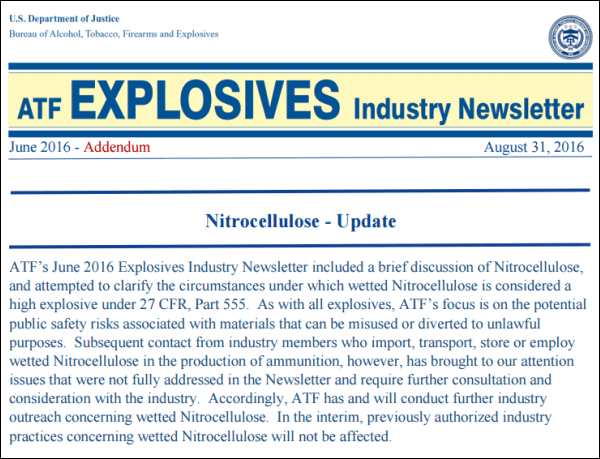ATF Defers Change to Smokeless Powder Classifications

Smokeless Powder Photo courtesy GunsAmerica.com, Reloading Powder Feature.
There has been a hue and cry on some internet sites about changes in smokeless powder classifications by the Federal Bureau of Alcohol, Tobacco, Firearms and Explosives (ATF). Writers have been concerned that recent interpretations by the ATF would make it much more difficult to store and transport reloading powders, which in turn could lead to price increases and/or powder shortages. Concern arose over the potential re-classification of “wetted” Nitrocellulose as a “high explosive”. Since “high explosives” are subject to more stringent rules, such re-classification would alter the way common smokeless propellants could be lawfully stored and transported.
Thankfully, there is good news. On August 31st the ATF issued an Addendum to its June 16 ATF Explosives Industry Newsletter saying that its policies regarding smokeless powders containing Nitrocellulose will not change… at least for now:

Based on this “Addendum”, it seems the ATF has tabled its proposal to classify Nitrocellulose-based smokeless powders as “high explosives”.
The NRA Institute for Legislative Action (NRA ILA) confirms that the ATF has backed off, so that current practices for powder storage and transport can continue unchanged. Thus hand-loaders should NOT face an impending powder shortage and/or price hikes. Here is the NRA ILA’s report:
ATF Delays Any Changes to Nitrocellulose Regulation
Earlier this summer, ATF released an Explosives Industry Newsletter that changed the agency’s treatment of nitrocellulose, the primary component in smokeless powders used in modern ammunition. This change had the potential to seriously disrupt ammunition supply in the United States because it changed a long-standing ATF policy that exempted properly “wetted” nitrocellulose from treatment as an explosive under federal law.NRA and [shooting industry representatives] raised these concerns to ATF and any change in ATF’s treatment of nitrocellulose is now officially delayed. In an addendum to the earlier newsletter, ATF announced that it “will conduct further industry outreach concerning wetted Nitrocellulose. In the interim, previously authorized industry practices concerning wetted Nitrocellulose will NOT be affected.”
While the addendum doesn’t indicate that ATF has permanently abandoned this change to nitrocellulose regulation, smokeless powder manufacturers will be permitted to continue normal operation, at least for the time being. NRA will continue to work to ensure that any future change to nitrocellulose regulation will not affect ammunition supply.
ATF Industry Newsletter Caused Concern
The cause for firearms industry concern was the ATF’s statement about Nitrocellulose published in the June 2016 ATF Explosives Industry Newsletter. The key language is shown in the right column below. According to the NRA ILA, the ATF has, at least for the time being, decided NOT to change its policies regarding the storage and transport of “wetted” Nitrocellulose. Accordingly, “smokeless powder manufacturers will be permitted to continue normal operation”.













 For those who enjoy reactive targets that explode with a big bang and a cloud of smoke, binary compounds are available from a variety of vendors, including
For those who enjoy reactive targets that explode with a big bang and a cloud of smoke, binary compounds are available from a variety of vendors, including 




